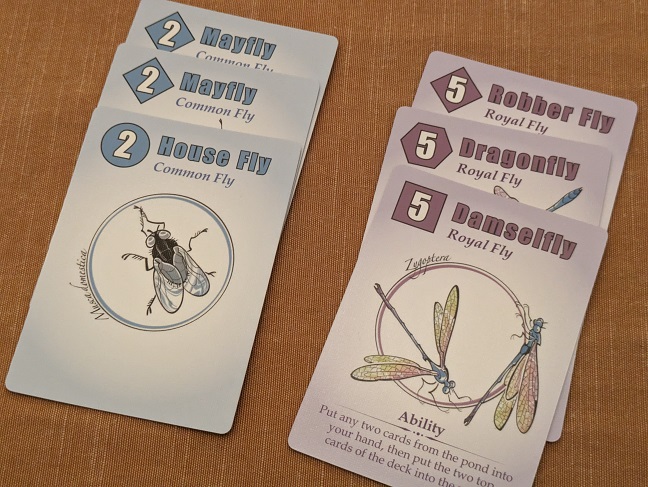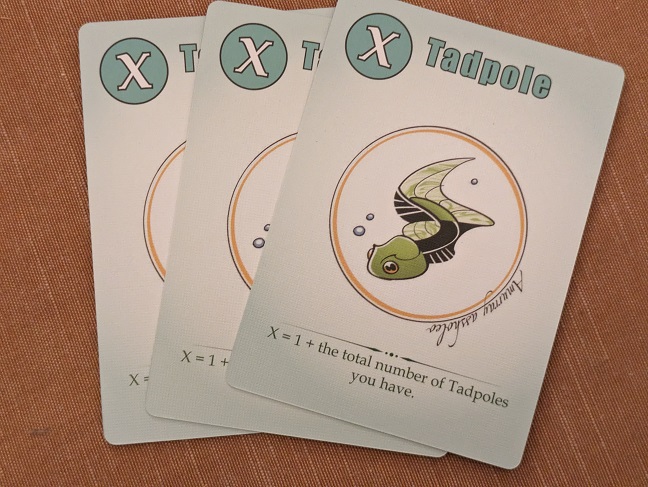Jenna Felli has a fascination with frogs. These creatures sit in an awkward spot, adapting their profile depending on perspective and context. They can appear as cute little buggers full of character and personality, or they can be slimy and horrific monsters. Sometimes they’re helpful and wise, the kind of friend you’d want to stumble upon in a children’s story. Other times they’re vile and poisonous, the type of villain that devours families of fruit flies, or even entire worlds.
Felli’s latest design is a card game that features such an amphibian as its central character. This frog just so happens to be an a**hole.

This is a “take that” card game. That means it pits players against each other, often by overturning moves or nicking progress. It’s the type of experience that can be difficult to pull off. This style of game frequently relies on direct aggression and unpredictable tempo to attempt dramatic highs, but often fails to provide a scaffolding that is substantial or strategically compelling enough to manufacture player investment. If I’m being honest, some of the worst tabletop games fall into this category. Murray the A**hole Frog is not one of those games.
It’s easy to think of this as Felli’s take on Rummy. You’re drawing from a shared deck of various flies and trying to collect sets. Each of these bugs is divided into a type designated by color, as well as a subtype indicated by shape. So, there are house flies and mayflies that are both blue and grouped together at the top of the hierarchy. But one has a circle sub-type and the other a diamond. There are fruit flies, and midges, and soldier flies. They’re all over the goddamn place and coming out the walls.
The goal is to gather these in your hand and then play them to the table on your turn as a swarm. Swarms must be the same color and played as a group of three or more. Alternatively, you can add to a swarm you already have. Draw another beady-eyed house fly? Plop it down with the other stack of three buzzing around in your play area.

Amassing swarms is the routine labor. What you’re really aiming for are groups of identical sub-types, as well as clusters of at least four flies. Each of these conditions, especially in tandem, award bonus points and can really rip open your point ceiling. They also make juicy targets.
I know flies have rudimentary memory, but it’s not beyond your faculties to recall that this is a “take that” game. It means your sh*t ain’t safe.
Some of the flies have special abilities. They can be played to trigger these effects instead of deploying them to a swarm. Robber flies let you rob. You can take two flies from other players’ swarms and discard them. Damsel flies fidget with the river of faceup cards players can draw from. Fireflies get cancelled. Actually, they let you pull flies from other’s swarms into your hand.
But the game’s just getting warmed up. The real dickery comes from Murray.
When a Murray card is drawn from the deck it’s immediately resolved. It’s sort of like a bomb waiting patiently in the pond to explode. The active player then chooses any swarm on the table and the bloated bastard devours it. Just like that, your cloud of six crane flies is toast. Ribbit, ribbit.

There’s an obvious tension in building massive swarms with not wanting to overcommit and create large targets for Murray. There’s also an element of gambling, particularly late in this 40-minute game as you’re hoping Murray isn’t drawn one final time and decide to risk plopping out a big group of flies. It can get nerve-wracking when the frog is flipped and players start bickering over who should be the target of the toad’s wrath.
This is also where Felli’s design philosophy takes an interesting bend.
In many of her games, she employs a conviction of brutality. You can get pummeled in Cosmic Frog if another player wants to throw down. It can be strategically devastating to have spent multiple turns harvesting turf from the shard and then be forced to barf it all up. I have seen sessions of Duhr where a participant was wholly ganged up on, eliminated from competition and becoming a specter. The Mirroring of Mary King could be likened to two streetfighters tethered together and set aflame.
But now, at the behest of an a**hole frog, there appears to be a turn of sympathy. When Murray chomps on your swarm you are given a tadpole as recompense. At the end of the game, each tadpole is worth a point value of X, where X is one plus the number of tadpoles you possess. Say you’ve been unlucky and Murray really ran amok on you. In this case, your four tadpoles would be worth 20 points total. That’s a sizable chunk. This mechanism intentionally creates a point curve where it urges the violence be spread amongst the group. It’s a clever design decision, but it reveals a small inflection of compassion that was, let’s say, minimized in Felli’s earlier work.
Furthermore, the way Murray leaps from the pond and is indiscriminately wielded as a forced point of conflict is an interesting detail. It absolves the aggressor in two ways. First, they didn’t choose to pick up the sword. Fate dictated it, just as drawing your target in Cosmic Encounter is a blameless action. This softens the carnage a tad, modifying the context.
More compelling is the focus of ire being placed upon the character of Murray. By framing the game upon this destroyer of families, it provides an external object to mock and ridicule. If I draw Murray and swallow your fruit flies, I can apologize, and we can both point to the a**hole amphibian and curse his family. There’s a duality here that is sort of humorous but material. This dance of discomfort where you blow up people’s point havens and then laugh about it and curse the frog is the core tone of Murray the A**hole Frog. It’s what makes the game interesting and worth flirting with. The frog’s the asshole. Not me. The box says so.

If it wasn’t clear already, this is absolutely a Devious Weasel title. Besides the obvious inclination for violence, it espouses oddities such as the unique turn structure. This has players drawing two cards, then optionally performing several actions as many times as you’d like, and then calling for two concluding actions that are limited to just once per turn. Finally, you pass a card from your hand to the next player so they can begin their go. This leads to some persnicketies such as never being allowed to go down to a single card in hand. If this ever happens by accident through carelessness, you just have to unwind the action and fix it.
Compounding this inelegance is the minor difficulty in learning this straightforward game. I could teach it to you in a short minute, but it took considerably longer to learn the idiosyncracies on our first play. This is primarily due to the rules being spread across several double-sided cards. During the first session or two, play will come to a halt while someone flips back and forth between these reference cards looking for the relevant section to answer a rules query. It’s not an enormous hurdle, but it’s a bit of a hassle for learning the game.
Additionally, there’s a tender point in the design in that it’s surprisingly math-forward. When Murray is flipped, people often begin openly calculating points as they lobby for you to “attack Aaron, he’s winning by five right now.” The arithmetic isn’t complex, it’s just a touch crude when the game is otherwise a rather nimble rules-light game of Rummy with viciousness.
Some of the math facilitates delightful strategic tradeoffs. For instance, any cards in your hand at the end of play count as negative points. This is another really cruel aspect that can lead to an opaque end game with a surprising amount of suspense as scores are totaled.
It’s all interesting, even when it’s a smidge slow or awkward. It’s also reasonably fulfilling for a short filler that comes in a deck box. I’d be surprised if anyone regarded this in the same expressive light as Mary King, or with the same dramatic acuity as Cosmic Frog. But it’s a mean croaker that offers a few laughs and requires some reasoning. It’s also quirky and unapologetically Jenna Felli.
A review copy of the game was provided by the publisher.
If you enjoy what I’m doing and want to support my work, please consider dropping off a tip at my Ko-Fi or supporting me on Patreon.

*Loved* the “Firefly” reference! Well-played, Charlie!
LikeLiked by 1 person
I couldn’t help myself.
LikeLike